Improving Biodegradation of Clofibric Acid by Trametes pubescens through the Design of Experimental Tools
Abstract
:1. Introduction
2. Materials and Methods
2.1. Chemicals and Fungal Strain
2.2. Bioremediation Experiments
2.3. Biomass Dry Weight Assay
2.4. HPLC Analysis
2.5. Design of Experiments Methodology
2.5.1. Screening of Important Biotechnological Parameters by Plackett-Burman Design
2.5.2. Central Composite Design (CCD) and Response Surface Methodology (RSM)
+ β22C2 + β33F2 + β44H2
2.6. Statistical Analysis
3. Results
3.1. Selection of Significant Biotechnological Parameters on the CLF Biodegradation by Using PBD
3.2. Model Fitting and Statistical Analysis
+ 0.63 CH + 3.75 FH + 0.21 B2 − 3.96 C2 + 3.33 F2 + 3.33 H2
4. Discussion
5. Conclusions
Author Contributions
Funding
Acknowledgments
Conflicts of Interest
References
- Kummerer, K. Pharmaceuticals in the environment. Annu. Rev. Environ. Resour. 2010, 35, 57–75. [Google Scholar] [CrossRef] [Green Version]
- Sacher, F.; Lange, F.T.; Brauch, H.J.; Blankenhorn, I. Pharmaceuticals in ground waters: Analytical methods and results of a monitoring program in Baden-Württemberg, Germany. J. Chromatogr. A 2001, 938, 199–210. [Google Scholar] [CrossRef]
- Sahinkaya, E.; Dilek, F.B. Biodegradation of 4-chlorophenol by aclimated and unacclimated activated sludge—Evaluation of biokinetic coefficients. Environ. Res. 2005, 99, 243–252. [Google Scholar] [CrossRef] [PubMed]
- Sirés, I.; Cabot, P.L.; Centellas, F.; Garrido, J.A.; Rodríguez, R.M.; Arias, C.; Brillas, E. Electrochemical degradation of clofibric acid in water by anodic oxidation comparative study with platinum and boron-doped diamond electrodes, Electrochim. Acta 2006, 52, 75–85. [Google Scholar]
- Sirés, I.; Arias, C.; Cabot, P.L.; Centellas, F.; Garrido, J.A.; Rodríguez, R.M.; Brillas, E. Degradation of clofibric acid in acidic aqueous medium by electro-Fenton and photoelectron-Fenton. Chemosphere 2007, 66, 1660–1669. [Google Scholar] [CrossRef] [PubMed]
- Favier, L.; Rusu, L.; Simion, A.I.; Hlihor, R.M.; Pacala, M.L.; Augustyniak, A. Efficient degradation of clofibric acid by heterogeneous photocatalytic oxidation process. Environ. Eng. Manag. J. 2019, 18, 1683–1692. [Google Scholar] [CrossRef]
- Doll, T.E.; Frimell, F.H. Kinetic study of photocatalytic degradation of carbamazepine, clofibric acid, iomeprol and iopromide assited by different TiO2 materials. Determination of intermediates and reaction pathways. Water Res. 2004, 38, 955–964. [Google Scholar] [CrossRef]
- Prpich, P.G.; Daugulis, A.G. Enhanced biodegradation of phenol by a microbial consortium in a solid liquid two-phase partitioning bioreactor. Biodegradation 2005, 16, 329–339. [Google Scholar] [CrossRef]
- Agarry, S.E.; Durojaiye, A.O.; Yusuf, R.O.; Aremu, M.O.; Solomon, B.O. Biodegradation of phenol in refinery wastewater by pure cultures of Pseudomonas aeruginosa NCIB 950 and Pseudomonas fluorescence NCIB 3756. Int. J. Environ. Pollut. 2008, 32, 3–11. [Google Scholar] [CrossRef]
- Gadd, G.M. Fungi in Bioremediation; Cambridge University Press: New York, NY, USA, 2001. [Google Scholar]
- Asgher, M.; Bhatti, H.N.; Ashraf, M.; Legge, R.L. Recent development in biodegradation of industrial pollutants by white rot fungi and their enzyme system. Biodegradation 2008, 19, 771–783. [Google Scholar] [CrossRef]
- Marco-Urrea, E.; Miriam, P.T.; Teresa, V.; Gloria, C. Ability of White-Rot Fungi to Remove Selected Pharmaceuticals and Identification of Degradation Products of Ibuprofen by Trametes Versicolor. Chemosphere 2008, 7474, 765–772. [Google Scholar] [CrossRef] [PubMed]
- Ungureanu, C.V.; Balaes, T.; Favier, L.; Tanase, C.; Bahrim, G. White-rot fungus implications in clofibric acid biodegradation. Rom. Biotechnol. Lett. 2015, 20, 10388–10395. [Google Scholar]
- Bajaj, M.; Galbert, C.; Winter, J. Phenol degradation kinetics of an aerobic mixed culture. Biochem. Eng. J. 2009, 46, 205–209. [Google Scholar] [CrossRef]
- Abdel-Fattah, Y.R.; Saeed, H.M.; Gohar, Y.M.; El-Baz, M.A. Improved production of Pseudomonas aeruginosa uricase by optimization of process parameters through statistical experimental designs. Process. Biochem. 2005, 40, 707–714. [Google Scholar] [CrossRef]
- Ghanem, K.M.; Al-Garni, S.M.; Makishah, A. Statistical optimization of cultural conditions for chitinase production from fish scales waste by Aspergillus terreus. Afr. J. Biotechnol. 2010, 9, 5135–5146. [Google Scholar]
- Levin, L.; Papinutti, L.; Forchiassin, F. Evaluation of Argentinean white rots fungi for their ability to produce lignin-modifying enzymes and decolorize industrial dyes. Bioresour. Technol. 2004, 94, 169–176. [Google Scholar] [CrossRef]
- Balaeş, T.; Tanase, C. Optimization of nutritional conditions for the mycoremediation of the synthetic dyes. Rom. Biotech. Lett. 2013, 18, 8804–8811. [Google Scholar]
- Guo, W.Q.; Ren, N.Q.; Wang, X.J.; Xiang, W.S.; Ding, J.; You, Y. Optimization of culture conditions for hydrogen production by Ethanoligenes harbinense B49 using response surface methodology. Bioresour. Technol. 2009, 100, 1192–1196. [Google Scholar] [CrossRef]
- Zu, L.; Li, G.; An, J.; Li, J.; An, T. Kinetic optimization of biodegradation and debromination of 2,4,6-tribromophenol using response surface methodology. Int. Biodeter. Biodegrad. 2013, 76, 18–23. [Google Scholar] [CrossRef]
- Kasonga, T. Optimization of the South African indigenous fungal growth for the degradation of diclofenac sodium from water. BioRxiv 2018. [CrossRef]
- Cornelissen, G.; Sijm, D.T. An energy budget model for the biodegradation and co-metabolism of organic substances. Chemosphere 1996, 33, 817–830. [Google Scholar] [CrossRef]
- Harder, W.; Dijkhuizen, I.; Postgate, J.R. Strategies of mixed substrate utilization in microorganisms, Philosophical Transactions of the Royal Society of London Series B. Biol. Sci. 1982, 297, 459–480. [Google Scholar]
- Rutger, M.; Balk, P.A.; van Dam, K. Quantification of multiple-substrate controlled growth-simultaneous ammonium and glucose limitation in chemostat cultures of Klebsiella pneumoniae. Arch. Microbiol. 1990, 153, 478–484. [Google Scholar] [CrossRef] [PubMed]
- Egli, T. On multiple-nutrient-limited growth of microorganisms with special reference to dual limitation by carbon and nitrogen substrates. Antonie van Leeuwenhoek J Microbiol. 1991, 60, 225–234. [Google Scholar] [CrossRef]
- Egli, T. The ecological and physiological significance of the growth of heterotrophic microorganisms with mixtures of substrate. Adv. Microb. Ecol. 1995, 14, 305–386. [Google Scholar]
- Meyer, J.S.; Marcus, M.D.; Bergman, H.L. Inhibitory interactions of aromatic organics during microbial degradation. Environ. Toxicol. Chem. 1984, 3, 583–587. [Google Scholar] [CrossRef]
- Saez, P.B.; Rittmann, B.E. Biodegradation kinetics of 4-chlorophenol, an inhibitory co-metabolite. Res. J. Water Pollut. Control Fed. 1991, 63, 838–847. [Google Scholar]
- Suflita, J.M. Microbial ecology and pollutant biodegradation in subsurface ecosystems. In U.S. Environmental Protection Agency, Seminar Publication-Transport and Fate Contaminants in the Subsurface; EPA: Washington, DC, USA, 1989; pp. 67–84. [Google Scholar]
- Moore-Landecker, E. Fundamentals of the Fungi, 4th ed.; Prentice-Hall: Upper Saddle River, NJ, USA, 1996; p. 674. [Google Scholar]
- Larsson, D.G.; de Pedro, C.; Paxeus, N. Effluent from drug manufactures contains extremely high levels of pharmaceuticals. J. Hazard. Mater. 2007, 148, 751–755. [Google Scholar] [CrossRef]
- Tran, N.H.; Urase, T.; Kusakabe, O. The characteristics of enriched nitrifier culture in the degradation of selected pharmaceutically active compounds. J. Hazard. Mater. 2009, 171, 1051–1057. [Google Scholar] [CrossRef]
- Popa, C.; Favier, L.; Dinica, R.; Semrany, S.; Djelal, H.; Amrane, A.; Bahrim, G. Potential of newly wild Streptomyces stains as agents for the biodegradation of a recalcitrant pharmaceutical, carbamazepine. Environ. Technol. 2014, 35, 3082–3091. [Google Scholar] [CrossRef]
- Popa Ungureanu, C.; Favier, L.; Bahrim, G.; Amrane, A. Response Surface Optimization of Experimental Conditions for Carbamazepine Biodegradation by Streptomyces MIUG 4.89. New Biotechnol. 2015. [Google Scholar] [CrossRef]
- Popa Ungureanu, C.; Favier, L.; Bahrim, G. Screening of soil bacteria as potential agents for drugs biodegradation: A case study with clofibric acid: Soil bacteria as potential agents for drugs biodegradation. J. Chem. Technol. Biotechnol. 2016, 91, 1646–1653. [Google Scholar] [CrossRef]
- Hemidouche, S.; Favier, L.; Amrane, A.; Dabert, P.; Le Roux, S.; Sadaoui, Z. Successful Biodegradation of a Refractory Pharmaceutical Compound by an Indigenous Phenol-Tolerant Pseudomonas aeruginosa Strain. Water Air Soil Pollut. 2018, 229, 103. [Google Scholar] [CrossRef]
- Wang, S.J.; Loh, K.C. Facilitation of cometabolic degradation of 4-chlorophenol using glucose as an added growth substrate. Biodegradation 1999, 10, 261–269. [Google Scholar] [CrossRef] [PubMed]
- Fakhruddin, A.N.M.; Quilty, B. The influence of glucose and fructose on the degradation of 2-chlorophenol by Pseudomonas putida CP1. World J. Microbiol. Biotechnol. 2005, 21, 1541–1548. [Google Scholar] [CrossRef]
- Dutta, D.; Das, M.D. Effect of C/N ratio and microelements on nutrient dynamics and cell morphology in submerged fermentation of Aspergillus giganteus MTCC 8408 using Taguchi DOE. Biotechnology 2017, 7, 1–8. [Google Scholar] [CrossRef] [Green Version]
- Zhou, J.; Yu, X.; Ding, C.; Wang, Z.; Zhou, Q.; Pao, H.; Cai, W. Optimization of phenol degradation by Candida tropicalis Z-04 using Plackett-Burman design and response surface methodology J. Environ. Sci. 2011, 231, 22–30. [Google Scholar] [CrossRef]
- Ghanem, K.M.; Al-Fassi, F.A.; Al-Hazmi, N.M. Optimization of Chloroxylenol Degradation by Aspergillus Niger Using Plackett-Burman Design and Response Surface Methodology. Rom. Biotech. Lett. 2013, 18, 7983–7994. [Google Scholar]
- Sultan, S.; Hasnain, S. Reduction of toxic hexavalent chromium by Ochrobacterium intermedium strain SDCr-5 stimulated by heavy metals. Bioresour. Technol. 2007, 98, 340–344. [Google Scholar] [CrossRef]
- Zeddel, A.; Majcherczyk, A.; Huttermann, A. Degradation of polychlorinated-biphenyls by white-rot fungi Pleurotus ostreatus and Trametes versicolor in a solid-state system. Toxicol. Environ. Chem. 1993, 40, 255–266. [Google Scholar] [CrossRef]
- Wesenberg, D.; Kyriakides, I.; Agathos, S.N. White rot fungi and their enzymes for the treatment of industrial dye effluents. Biotechnol. Adv. 2003, 22, 161–187. [Google Scholar] [CrossRef] [PubMed]
- Ikeda, K.; Naghashkar, N.; El-Din, M.G. Degradation of aqueous pharmaceuticals by ozonation and advanced oxidation process: A review. Ozone Sci. Eng. 2006, 28, 353–414. [Google Scholar]
- Call, H.P.; Muche, I. Minireview: History, overview and applications of mediated ligninolytic systems, especially laccase-mediator-systems (Lignozym-Process). J. Biotechnol. 1997, 53, 163–202. [Google Scholar] [CrossRef]
- Tien, M.; Kirk, T.K. Lignin peroxidase of Phanerochaete chrysosporium. In Methods in Enzymology-Biomass, Part B, Lignin, Pectin, and Chitin; Wood, W.A., Klogg, S.T., Eds.; Academic Press: San Diego, CA, USA, 1988; Volume 161, pp. 238–249. [Google Scholar]
- Tran, N.H.; Urase-Kusakabe, O. Biodegradation characteristics of pharmaceutical substances by whole fungal culture Trametes versicolor and its laccase. J. Water Environ. Technol. 2010, 8, 125–140. [Google Scholar] [CrossRef] [Green Version]
- Zhang, Y.; Geiben, S.U. In vitro degradation of carbamazepine and diclofenac by crude lignin peroxidase. J. Hazard. Mater. 2013, 176, 1089–1092. [Google Scholar] [CrossRef] [PubMed]
- Shrestha, T.J.; Liou, O.K.; Sohng, J.K. Cytochrome P450 (CYP105F2) from Streptomyces peucetius and its activity with oleandomycin. Appl. Microbiol. Biotechol. 2008, 79, 555–562. [Google Scholar] [CrossRef] [PubMed]
- Evangelista, S.; Cooper, D.G.; Yargeau, V. The effect of structure and a secondary carbon source on the microbial degradation of chlorophenoxy acids. Chemosphere 2010, 79, 1084–1088. [Google Scholar] [CrossRef] [Green Version]
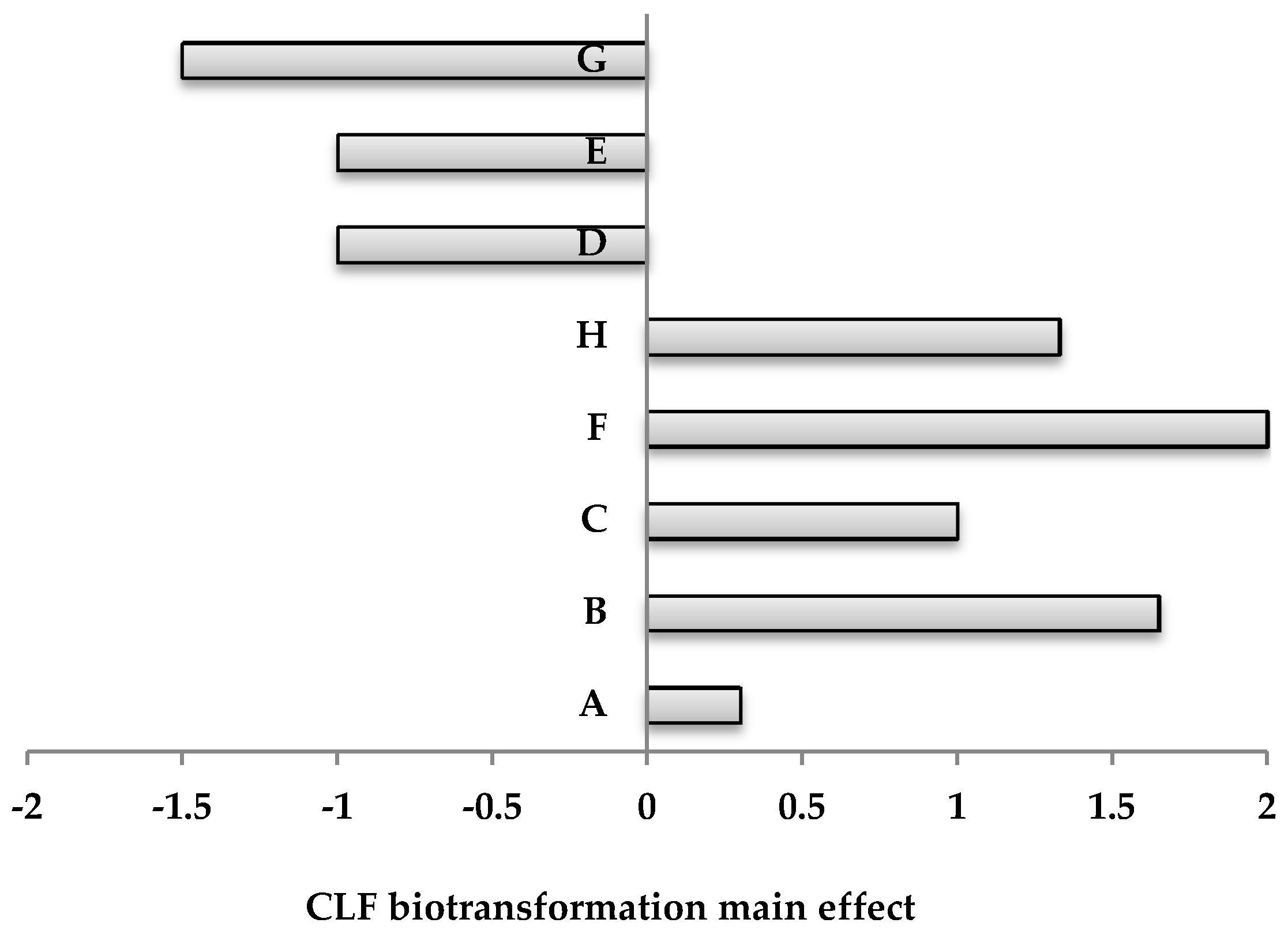
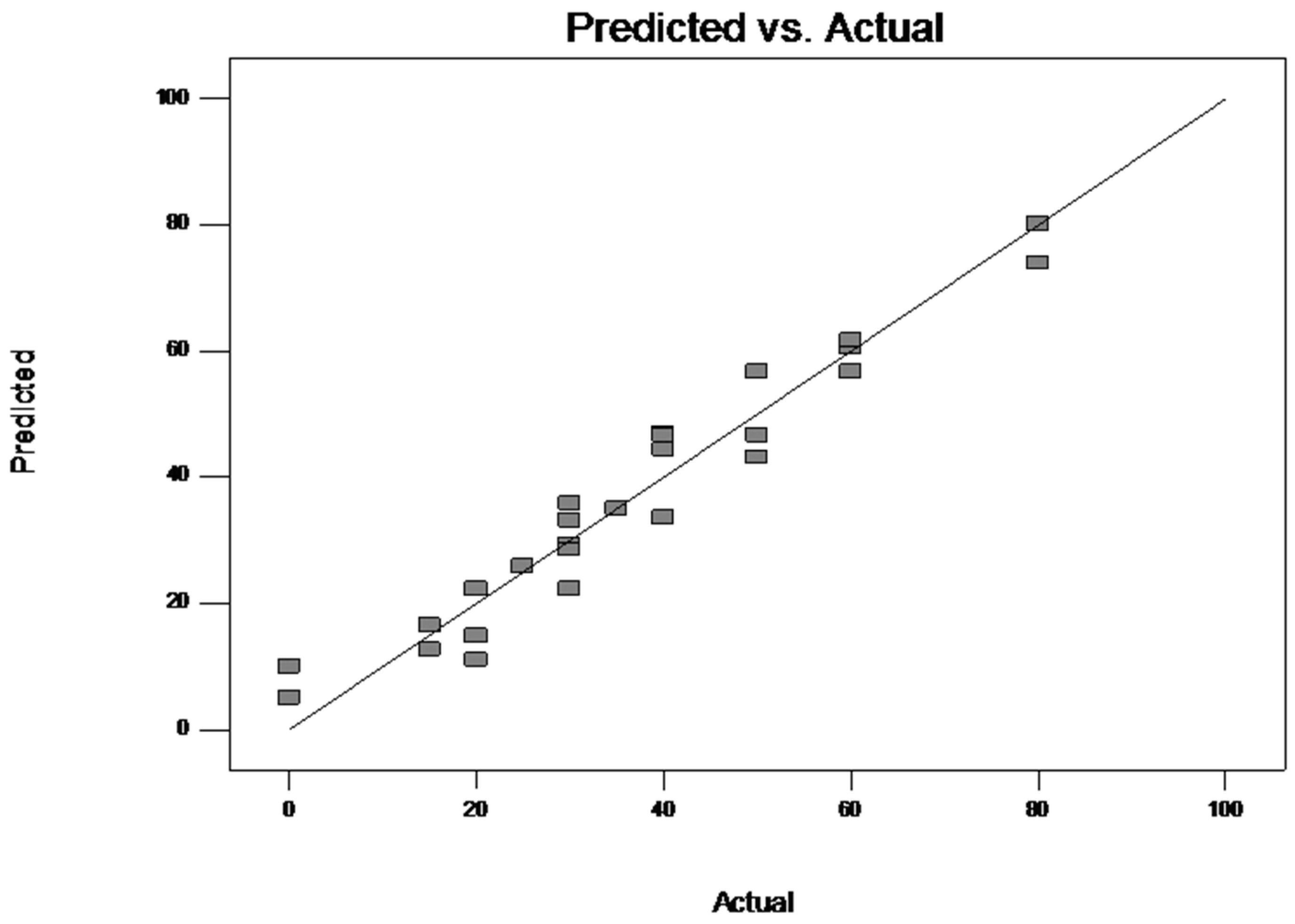
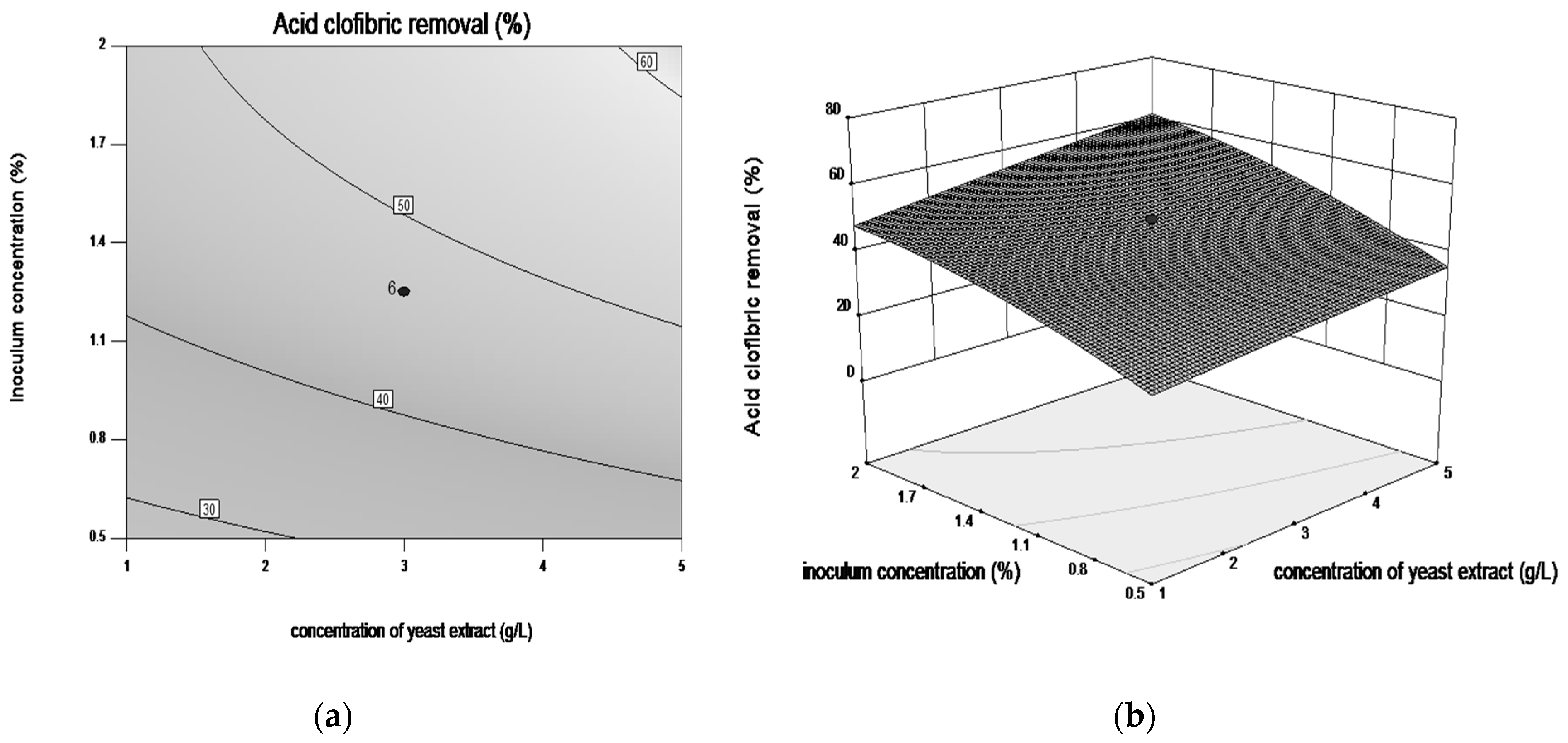
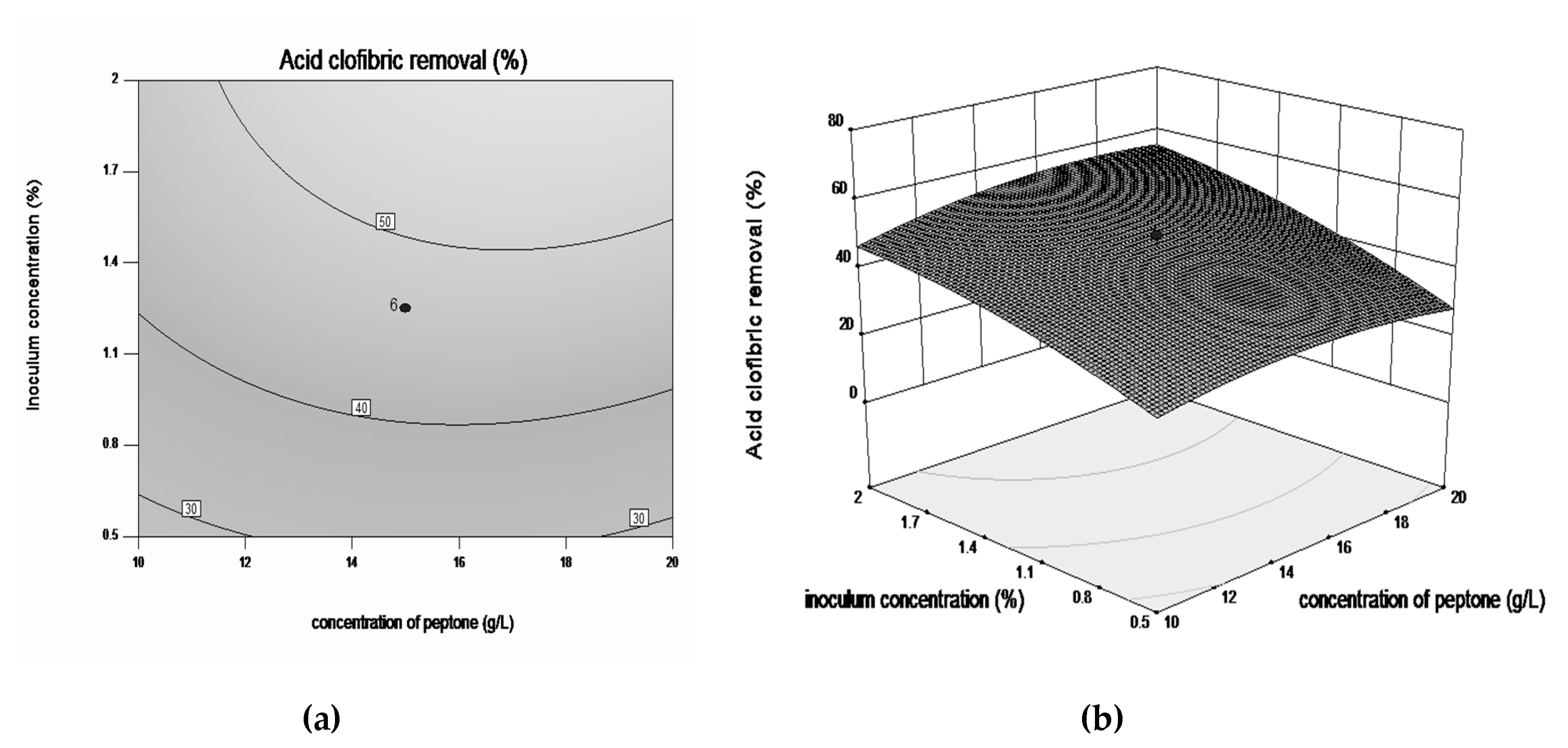

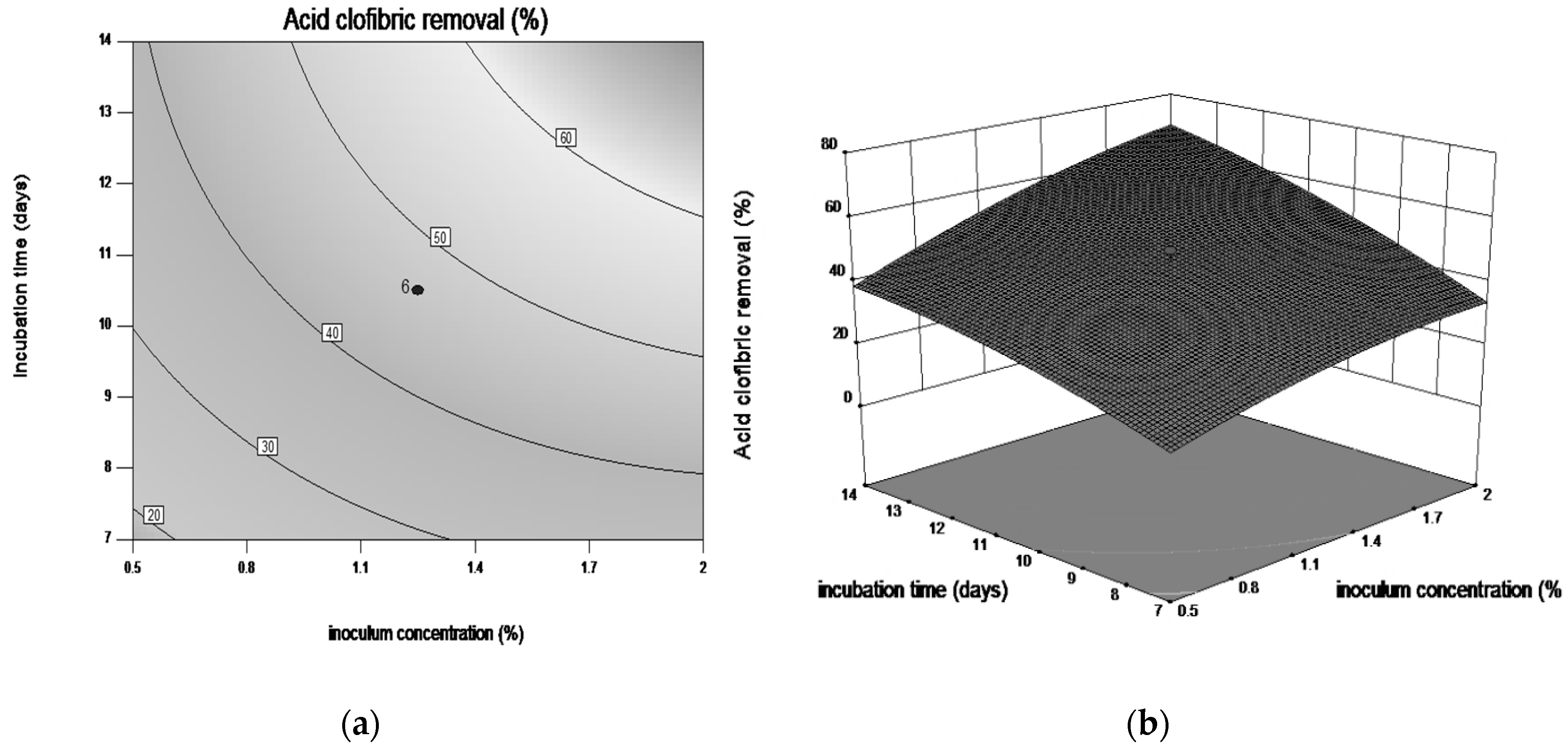
| Variables | Units | Symbol | Coded Levels (χi) | |
|---|---|---|---|---|
| −1 | +1 | |||
| Glucose | g·L−1 | A | 5.0 | 10.0 |
| Yeast extract | g·L−1 | B | 1.0 | 5.0 |
| Peptone | g·L−1 | C | 10.0 | 20.0 |
| CuSO4·5H2O | g·L−1 | D | 0.1 | 0.5 |
| MnSO4·H2O | g·L−1 | E | 0.1 | 0.5 |
| Inoculum level | % v/v | F | 0.5 | 2.0 |
| CLF concentration | mg·L−1 | G | 10.0 | 15.0 |
| Incubation time | days | H | 7.0 | 14.0 |
| Independent Variables | Coded Levels | |||||
|---|---|---|---|---|---|---|
| Symbol | −α | −1 | 0 | +1 | α | |
| Concentration of yeast extract, g·L−1 | B | 0 | 1 | 3 | 5 | 7 |
| Concentration of peptone, g·L−1 | C | 5 | 10 | 15 | 20 | 25 |
| Inoculum concentration, % (v/v) | F | 0.2 | 0.5 | 1.25 | 2 | 2.75 |
| Incubation time, days | H | 4 | 7 | 10.5 | 14 | 17.5 |
| Run | Coded Levels of Variable | Biodegradation Yield of CLF, (%) | |||||||
|---|---|---|---|---|---|---|---|---|---|
| A | B | C | D | E | F | G | H | ||
| 1 | −1 | 1 | 1 | 1 | −1 | 1 | 1 | −1 | 30.00 |
| 2 | −1 | −1 | −1 | −1 | −1 | −1 | −1 | −1 | 40.00 |
| 3 | −1 | −1 | −1 | 1 | 1 | 1 | −1 | 1 | 70.00 |
| 4 | 1 | −1 | −1 | −1 | 1 | 1 | 1 | −1 | 30.00 |
| 5 | 1 | 1 | 1 | −1 | 1 | 1 | −1 | 1 | 100.00 |
| 6 | 1 | 1 | −1 | 1 | 1 | −1 | 1 | −1 | 40.00 |
| 7 | −1 | 1 | −1 | −1 | −1 | 1 | 1 | 1 | 40.00 |
| 8 | 1 | −1 | 1 | 1 | −1 | 1 | −1 | −1 | 40.00 |
| 9 | 1 | −1 | 1 | −1 | −1 | −1 | 1 | 1 | 20.00 |
| 10 | −1 | −1 | 1 | 1 | 1 | −1 | 1 | 1 | 25.00 |
| 11 | −1 | 1 | 1 | −1 | 1 | −1 | −1 | −1 | 40.00 |
| 12 | 1 | 1 | −1 | 1 | −1 | −1 | −1 | −1 | 75.00 |
| Run | Independent Variable Variation, Coded Levels | CLF Biotransformation Yield, (%) | ||||
|---|---|---|---|---|---|---|
| B | C | F | H | Experimental Values | Predicted Values | |
| 1 | 0 | 0 | 0 | 0 | 47.18 | 46.67 |
| 2 | 0 | 0 | 2 | 0 | 60.25 | 56.67 |
| 3 | 0 | 0 | 0 | 0 | 47.20 | 46.67 |
| 4 | 0 | 0 | −2 | 0 | 0.00 | 2.00 |
| 5 | 1 | 1 | −1 | 1 | 49.30 | 43.13 |
| 6 | −1 | 1 | 1 | 1 | 59.88 | 60.63 |
| 7 | 0 | 2 | 0 | 0 | 36.20 | 35.83 |
| 8 | −1 | −1 | 1 | −1 | 21.40 | 22.29 |
| 9 | 0 | 0 | 0 | 0 | 47.78 | 46.67 |
| 10 | −1 | −1 | −1 | −1 | 28.25 | 22.29 |
| 11 | 1 | −1 | −1 | −1 | 19.97 | 14.79 |
| 12 | −1 | 1 | −1 | 1 | 29.35 | 28.54 |
| 13 | −1 | −1 | 1 | 1 | 47.20 | 46.87 |
| 14 | 0 | 0 | 0 | 0 | 47.25 | 46.67 |
| 15 | 1 | 1 | 1 | −1 | 30.35 | 33.13 |
| 16 | 1 | −1 | 1 | −1 | 30.03 | 29.38 |
| 17 | 0 | −2 | 0 | 0 | 25.35 | 25.38 |
| 18 | −1 | 1 | −1 | 1 | 17.80 | 16.46 |
| 19 | 2 | 0 | 0 | 0 | 55.99 | 56.67 |
| 20 | 1 | −1 | −1 | 1 | 43.99 | 44.38 |
| 21 | −2 | 0 | 0 | 0 | 35.00 | 35.00 |
| 22 | 0 | 0 | 0 | 2 | 60.99 | 61.67 |
| 23 | 1 | 1 | −1 | −1 | 13.20 | 11.04 |
| 24 | 0 | 0 | 0 | 0 | 49.25 | 46.67 |
| 25 | 0 | 0 | 0 | 0 | 49.45 | 46.67 |
| 26 | 1 | −1 | 1 | 1 | 60.25 | 53.96 |
| 27 | −1 | 1 | 1 | −1 | 30.25 | 33.54 |
| 28 | 0 | 0 | 0 | −2 | 0.00 | 2.00 |
| 29 | 1 | 1 | 1 | 1 | 60.98 | 59.21 |
| 30 | −1 | −1 | −1 | −1 | 15.30 | 12.71 |
| Source | Sum of Squares | Degree of Freedom | Mean Square | F Value | p Value Prob > F |
|---|---|---|---|---|---|
| Model | 10544.58 | 14 | 753.18 | 15.36 | <0.0001 |
| B | 704.17 | 1 | 704.17 | 14.36 | 0.0007 |
| C | 150.00 | 1 | 150.00 | 3.06 | 0.0018 |
| F | 3266.67 | 1 | 3266.67 | 66.63 | <0.0001 |
| H | 4816.67 | 1 | 4816.67 | 98.24 | <0.0001 |
| BC | 56.25 | 1 | 56.25 | 1.15 | 0.3010 |
| BF | 25.00 | 1 | 25.00 | 0.51 | 0.0361 |
| BH | 400.00 | 1 | 400.00 | 8.16 | 0.0120 |
| CF | 56.25 | 1 | 56.25 | 1.15 | 0.0310 |
| CH | 6.25 | 1 | 6.25 | 0.13 | 0.7260 |
| FH | 225.00 | 1 | 225.00 | 4.59 | 0.0490 |
| B2 | 1.19 | 1 | 1.19 | 0.024 | 0.8782 |
| C2 | 429.76 | 1 | 429.76 | 8.77 | 0.0097 |
| F2 | 304.76 | 1 | 304.76 | 6.22 | 0.0248 |
| H2 | 304.76 | 1 | 304.76 | 6.22 | 0.0248 |
| Residual | 735.42 | 15 | 49.03 | – | – |
| Lack of fit | 602.08 | 10 | 60.21 | 2.26 | 0.1908 |
| Pure error | 133.33 | 5 | 26.67 | – | – |
| Total | 11,280.00 | 29 | – | – | – |
© 2020 by the authors. Licensee MDPI, Basel, Switzerland. This article is an open access article distributed under the terms and conditions of the Creative Commons Attribution (CC BY) license (http://creativecommons.org/licenses/by/4.0/).
Share and Cite
Ungureanu, C.V.; Favier, L.; Bahrim, G.E. Improving Biodegradation of Clofibric Acid by Trametes pubescens through the Design of Experimental Tools. Microorganisms 2020, 8, 1243. https://doi.org/10.3390/microorganisms8081243
Ungureanu CV, Favier L, Bahrim GE. Improving Biodegradation of Clofibric Acid by Trametes pubescens through the Design of Experimental Tools. Microorganisms. 2020; 8(8):1243. https://doi.org/10.3390/microorganisms8081243
Chicago/Turabian StyleUngureanu, Claudia Veronica, Lidia Favier, and Gabriela Elena Bahrim. 2020. "Improving Biodegradation of Clofibric Acid by Trametes pubescens through the Design of Experimental Tools" Microorganisms 8, no. 8: 1243. https://doi.org/10.3390/microorganisms8081243
APA StyleUngureanu, C. V., Favier, L., & Bahrim, G. E. (2020). Improving Biodegradation of Clofibric Acid by Trametes pubescens through the Design of Experimental Tools. Microorganisms, 8(8), 1243. https://doi.org/10.3390/microorganisms8081243







